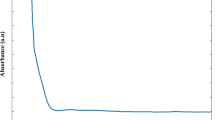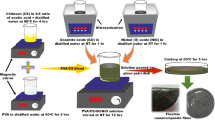Abstract
The effects of calcium carbonate (CaCO3) and calcium sulfate (CaSO4) nanoparticles on the thermal and UV-absorbing properties of polyvinyl acetate (PVAc) were analyzed in this study. Nanoparticles of CaCO3 and CaSO4 were synthesized by in situ deposition technique. The size and shape of nanoparticles were recognized by X-ray diffraction and scanning electron microscope (SEM) analyses which confirmed that the particle was having a diameter of 25–33 nm. In this technique, the surface modification of nanoparticles was done by non-ionic polymeric surfactant. PVAc/CaCO3 and PVAc/CaSO4 nanocomposites film samples with an average thickness of 30 µm and in the mass ratio of nanoparticles (0–4% (w/w)) were prepared by solution mixing technique. Chemical, structural, and elemental characterizations of nanocomposites were done by, fourier transform infrared, SEM, and energy dispersive X-ray spectroscopy analyses, respectively. Thermal properties of pure polymer and nanocomposites were characterized through differential scanning calorimetric, thermogravimetric, and differential thermogravimetry techniques. The glass transition temperature of nanocomposites increases with increase in content of nanoparticles. It may be due to the interaction between inorganic and organic components. The thermogravimetric analysis results indicate that the thermal degradation temperatures of nanocomposites were enhanced upon the addition of nanosized inorganic fillers. The thermal results show that PVAc/CaSO4 nanocomposites were more thermally stable than PVAc/CaCO3 nanocomposites. The addition of nanoparticles affects degradation mechanism and consequently improves thermal stability of PVAc. The reduction of polymer chain mobility and the tendency of nanoparticles to eliminate free radicals were the principal effects responsible for these enhancements. The ultraviolet–visible (UV–Vis) absorbance spectra of PVAc and its nanocomposites films show that the intensity of absorbance increases with increasing filling content, suggesting that nanocomposites films have greater UV-shielding property.
















Similar content being viewed by others
References
Bhiwankar NN, Weiss RA. Melt intercalation/exfoliation of polystyrene-sodium-montmorillonite nanocomposites using sulfonated polystyrene ionomer compatibilizers. Polymer. 2006;47:6684–91.
Schadler LS. Polymer-based and polymer-filled nanocomposites. New York: Wiley VCH; 2004.
Guar MS, Indolia AP. Thermally stimulated dielectric properties of polyvinyldenefluoride-zinc oxide nanocomposites. J Therm Anal Calorim. 2011;103:977–85.
Viratyaporn W, Lehman RL. Effect of nanoparticles on the thermal stability of PMMA nanocomposites prepared by in situ bulk polymerization. J Therm Anal Calorim. 2011;103:267–73.
Gaur MS, Rathore BS, Singh PK, Indolia A, Awasthi AM, Bhardwaj S. Thermally stimulated current and differential scanning calorimetry spectroscopy for the study of polymer nanocomposites. J Therm Anal Calorim. 2010;101:315–21.
Vodnik VV, Vukovic JV, Nedeljkovic JM. Synthesis and Characterization of silver-poly(methyl methacrylate) nanocomposites. Colloid Polym Sci. 2009;287:847–51.
Wang H, Peng X, Meng S, Zhong W, Du W, Du Q. Poly(methyl methacrylate)/silica/titania ternary nanocomposites with greatly improved thermal and ultraviolet-shielding properties. Polym Degrad Stab. 2006;91:1455–61.
Shimpi NG, Mishra S. Synthesis of nanoparticles and its effect on properties of elestomeric nanocomposites. J Nanopart Res. 2010;12:2093–9.
Rajkumar T, Vijayakumar CT, Sivasamy P, Sreedhar B, Wilkie CA. Thermal degradation studies on PMMA-HET acid based oligoesters blends. J Therm Anal Calorim. 2010;100:651–60.
Arora A, Choudhary V, Sharma DK. Effect of clay content and clay/surfactant on the mechanical, thermal and barrier properties of polystyrene/organoclay nanocomposites. J Polym Res. 2011;18:843–57.
Zubitur M, Mugica A, Areizaga J, Cortazar M. Morphology and thermal properties relationship in poly(p-dioxanone)/layered double hydroxides nanocomposites. Colloid Polym Sci. 2010;288:809–18.
Yang T, Brown RNC, Kempel LC, Kofinas P. Surfactant-modified nickel zinc iron oxide/polymer nanocomposites for radio frequency application. J Nanopart Res. 2010;12:2967–78.
Stojanovic D, Oriovic A, Markovic S, Radmilovic V, Uskokovic PS, Aleksic R. Nanosilica/PMMA composites obtained by the modification of silica nanoparticles in a supercritical carbon dioxide-ethanol mixture. J Mater Sci. 2009;44:6223–32.
Qian J, Zhang H, Cheng G, Huang Z, Dang S, Xu Y. Polypropylene wax (PPw)/silica hybrid by in situ non-aqueous sol-gel process for preparation of PP/silica nanocomposites. J Sol-Gel Sci Technol. 2010;56:300–9.
Shi S, Zhang L, Li J. Electrical and dielectric properties of multiwall carbon nanotube/polyaniline composites. J Polym Res. 2009;16:395–9.
Sun D, Miyatake N, Sue H. Transparent PMMA/ZnO nanocomposites films based on colloidal quantum dots. Nanotech. 2007;18:215606.
Zeng X, Kong X, Ge J, Liu H, Gao C, Shen Z, Chen J. Effective solution mixing method to fabricate highly transparent and optical functional organic-inorganic nanocomposites film. Ind Eng Chem Res. 2011;50:3253–8.
Mukherji M, Bose S, Nayak GC, Das CK. A study on the properties of PC/LCP/MWCNT with and without compatibilizers. J Polym Res. 2010;17:265–72.
Brydson JA. Plastics materials. London: Newnes-Butterworths; 1975.
Sivalingam G, Kartik R, Madras G. Blends of poly (e-caprolactone) and poly (vinyl acetate): mechanical properties and thermal degradation. Polym Deg Stab. 2004;84:345–52.
Sivalingam G, Madras G. Thermal degradation of ternary blends of poly (e-caprolactone)/poly (vinyl acetate)/poly (vinyl chloride). J Appl Polym Sci. 2004;93:1378–84.
Ochigbo SS, Luyt AS, Focke WW. Latex derived blends of poly(vinyl acetate) and natural rubber: thermal and mechanical properties. J Mater Sci. 2009;44:3248–54.
Gajria AM, Dave V, Gross RA, McCarthy SP. Miscibility and biodegradability of blends of poly (lactic acid) and poly (vinyl acetate). Polymer. 1996;37:437–44.
Prolongo MG, Arribas C, Salom C, Masegosa RM. Mechanical properties and morphology of epoxy/poly(vinyl acetate)/poly(4-vinyl phenol) brominated system. J Therm Anal Calorim. 2007;87:33–9.
Rodriguez NLG, Thielemans W, Dufresne A. Sisal cellulose whiskers reinforced polyvinyl acetate nanocomposites. Cellulose. 2006;13:261–70.
Amanuel S, Gaudette AN, Sternstein SS. Enthalpic relaxation of silica–polyvinyl acetate nanocomposites. J Polym Sci: Part B: Polym Phys. 2008;46:2733–40.
Jung HM, Lee EM, Ji BC, Deng Y, Yun JD, Yeum JH. Poly(vinyl acetate)/poly(vinyl alcohol)/montmorillonite nanocomposite microspheres prepared by suspension polymerization and saponification. Colloid Polym Sci. 2007;285:705–10.
Liu P, Gong K, Xiao P, Xiao M. Preparation and characterization of poly(vinyl acetate)-intercalated graphite oxide nanocomposites. J Mater Chem. 2000;10:933–5.
Mohsen-Nia M, Doulabi FSM. Synthesis and characterization of polyvinyl acetate/montmorillonite nanocomposite by in situ emulsion polymerization technique. Polym Bull. 2011;66:1255–65.
Masturi, Abdullah M, Khairurrijal. High compressive strength of home waste and polyvinyl acetate composites containing silica nanoparticle filler. J Mater Cycles Waste Manag. 2011;13:225–231. doi:10.1007/s10163-011-0012-2.
Pal MK, Singh B, Gautam J. Thermal stability and UV-shielding properties of polymethyl methacrylate and polystyrene modified with calcium carbonate nanoparticles. J Therm Anal Calorim. 2012;107:85–96. doi:10.1007/s10973-011-1686-3.
Mishra S, Mukherji A, Sharma DK. Nonisothermal crystallization modeling and simulation for polypropylene/nano CaSO4 composites with variation in nanosizes and wt% of loading. Polym-Plast Tech Eng. 2006;45:1191–8.
Lysikov AI, Salanov AN, Moroz EM, Okunev AG. Preparation of pure monodisperse calcium carbonate particles. React Kinet Catal Lett. 2007;90:151–7.
Rao KS, Anand S, Venkateswarlu P. Adsorption of cadmium from aqueous solution by Ficus religiosa leaf powder and characterization of loaded biosorbent. Clean–Soil Air Water. 2011;39:384–91.
Cullity BD. Elements of X-ray diffraction. Massachusetts: Addison-Wesley; 1965.
White WB. The carbonate minerals. In: Farmer VC, editor. The infrared spectra of minerals. London: Mineralogical Society; 1974.
Jikan SS, Ariff ZM, Ariffin A. Influence of filler content and processing parameter on the crystallization behaviour of PP/kaolin composites. J Therm Anal Calorim. 2010;102:1011–7.
Avella M, Cosco S, Di Lorenzo ML, Di Pace E, Errico ME, Gentile G. Nucleation activity of nanosized CaCO3 on crystallization of isotactic polypropylene, in dependence on crystal modification, particle shape, and coating. Eur Polym J. 2006;42:1548–57.
Peila R, Malucelli G, Priola A. Preparation and characterization of UV-cured acrylic nanocomposites based on modified organophilic montmorillonites. J Therm Anal Calorim. 2009;97:839–44.
Chang JH, Seo B, Hwang DH. An exfoliation of organoclay in thermotropic liquid crystalline polyester nanocomposites. Polymer. 2002;43:2969–74.
Sivalingam G, Karthik R, Madras G. Effect of metal oxides on thermal degradation of poly(vinyl acetate) and poly(vinyl chloride) and their blends. Ind Eng Chem Res. 2003;42:3647–53.
Nagabhusana H, Nagaraju G, Nagabhusana BM, Shivakumara C, Chakradhar RPS. Hydrothermal synthesis and characterization of CaSO4 pseudomicrorods. Philos Mag Lett. 2010;90:289–98.
Mikheeva OP, Sidorov AI. Optical nonlinearity of wide-bandgap semiconductor and insulator nanoparticles in the visible and near-infrared regions of the spectrum. Techn Phys. 2004;49:739–44.
Elimat ZM, Zihlif AM, Avella M. Thermal and optical properties of poly(methyl methacrylate)/calcium carbonate nanocomposites. J Experi Nanosci. 2008;3:259–69.
Acknowledgements
This research study was supported by the University Grant Commission, New Delhi (India). The authors gratefully acknowledge the facilities provided by the Department of Chemistry, Dr. B. R. Ambedkar University, Agra, India to carry out this study successfully. The authors thank the Director, STIC (SAIF) Kochi, and IIT Chennai (SAIF) Chennai for providing FT-IR, XRD, DSC, TG/DTG, SEM, and EDS characterization facilities.
Author information
Authors and Affiliations
Corresponding author
Rights and permissions
About this article
Cite this article
Pal, M.K., Gautam, J. Effects of inorganic nanofillers on the thermal degradation and UV-absorbance properties of polyvinyl acetate. J Therm Anal Calorim 111, 689–701 (2013). https://doi.org/10.1007/s10973-011-2153-x
Received:
Accepted:
Published:
Issue Date:
DOI: https://doi.org/10.1007/s10973-011-2153-x




